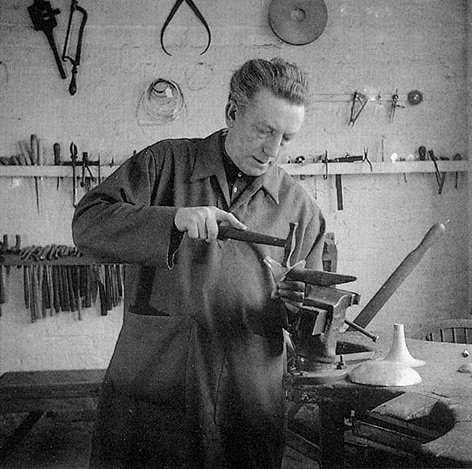- Born 1907, Died 1974
- Guild member 1934 – 1946, again 1968-1974
- Goldsmith and Silversmith, teacher

Dunstan Pruden learnt silversmithing at the Central School in London under Onslow Whiting, and then as assistant to the London goldsmith F. Morton Crookes. Born Alfred Charles Pruden, he took the name of Dunstan on his conversion to Catholicism. Brought up in a High Anglican environment, this was for him a small step, but one which later enabled him to work sympathetically for clients of both churches.

Shortly after completing his training, Pruden gave a lecture in London on Eric Gill. The event came to the notice of Gill himself, who contacted Pruden and found a young man very much in sympathy with his own notions of art and craftsmanship. Early in 1923 recommended Pruden to the Rector of Exeter College, Oxford for a commission to make a new altar cross in silver. Pruden received £250 for this important work, which was largely responsible for establishing his public reputation.
Later in the year, Pruden moved to Ditchling, and on 26 December was elected a “fully qualified postulant” to the Guild. Full membership followed on 6 May 1934. Pruden’s book Silversmithing was published by St Dominic’s Press and demonstrated the clarity of his approach, which provided the foundation for his teaching career at Brighton Art College, begun soon after his arrival at Ditchling and which lasted for over thirty years. At the same time, he fulfilled hundreds of commissions for ecclesiastical metalwork, ranging from chalices and candlesticks to crucifixes and croziers. The climax of this career was, the gold chalice made for the Metropolitan Cathedral in Liverpool in 1959.
In addition to work in silver, Pruden began to make objects in ivory, a development which can probably be attributed to the example of Philip Hagreen. Pruden also used the material to carve models for casting, finding it more responsive than plaster or wax, the usual media for models at this period. His commitment to the truthful use of materials and concern to maintain the highest quality of finish then led him to make his original casting models in silver, moulding and beating it, and creating the fine detail of drapery folds or the hair of a beard by soldering on individual fine wires.
His most original contribution was his technique of making figurative work directly in silver, instead of making casting patterns in wax or plaster of Paris. His work was conceived as metal, and as it grew under his hands he could judge exactly how it would look when it was finished. He regarded work executed in the conventional way as a mere copy in metal of a design in another medium.
His personality was somewhat different to other members of the Guild, being keen on continental travel and a devotee of French food. He had a wide range of friends including Lord Alfred Douglas the English poet and journalist best known as ‘Bosie’, the lover of Oscar Wilde.
Towards the end of his life, Pruden was stricken with Multiple Sclerosis. His second wife, the writer and critic Winefride Pruden took over the much of the preparatory work and later ran the workshop after his death, continuing the practice she had learned step by step from Dunstan.
Links
- Extracts from the unpublished autobiography So Doth the Smith
- Website of Pruden and Smith. Anton Pruden, Dunstan’s grandson is a partner in this firm of Bespoke Jewellers that operates from Ditchling High Street
- Obituary of Winefride Pruden

